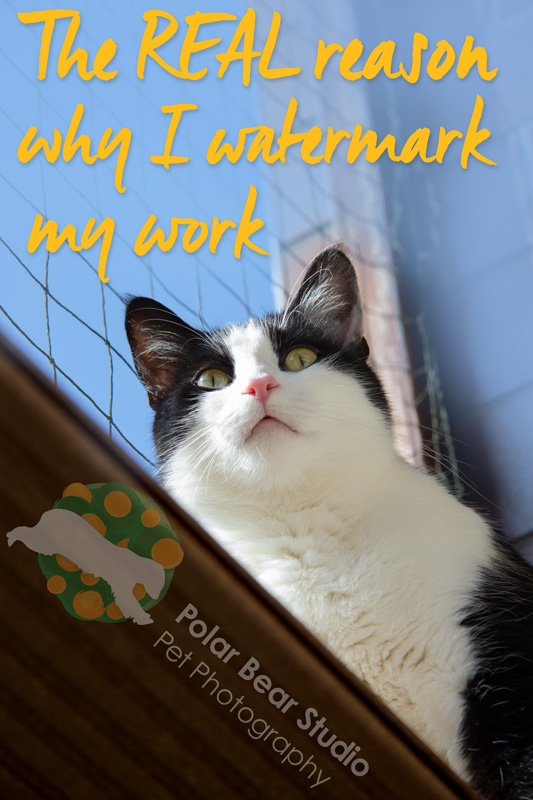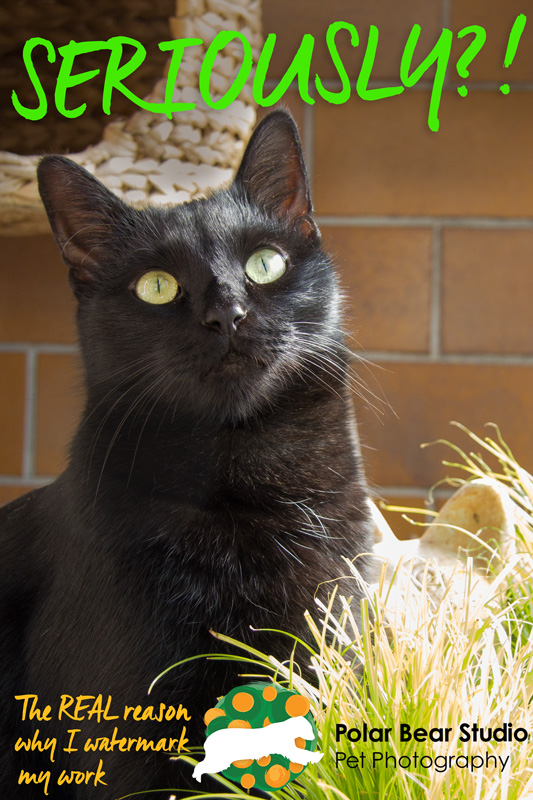The Real Reason Why I Watermark My Work
Monday, February 16, 2015 by Denise Subject MatterPet Photography
We’re friends; we have a common interest of loving animals as well as loving great images of them. As your friend, I want to tell you a secret. Which is the real reason why photographers use a watermark, a logo or copyright notice overlaying the photo, and trust me it is not what you think.

To keep things from getting TOO serious, I have my fur buddies Oscar (above), and Kalle (below) who will provide very shocked feline expressions for you.
I sense there is a misconception that a watermark’s sole purpose is to stop those who have had the photos taken from purchasing prints for cheap at the local 1-hour pharmacy, undercutting the photographer’s profit. That’s not the whole story, not even close. If you had a pie chart that would break down the reasons why a photographer uses a watermark, that would be perhaps 25% of the pie.
Finders Keepers
Imagine you’re in a parking lot, going into a store, and you find a wallet laying in the parking lot. You look around, and you don’t see anyone. What are you going to do?
If you’re an honest person who tries to ‘do unto others as you’d prefer others to do unto you’, you’ll look in the wallet to see if there’s any contact information to who it belongs to. Maybe go to the nearest store and see if anyone has reported the wallet missing, or you’ll go the police department and turn it in. Maybe if you’re a millennial*, born between 1980-2000, you’ll look up the person on Facebook and if you find the owner, you’ll message them that you found it. Regardless, with a wallet you’ll likely have a name for whom the wallet belongs to, a signature, and if you’re an honest person you’re going to try and do the right thing.
Now, imagine you’re in a parking lot, going into a store, and you find a 100 dollar bill. Again, you look around, and you don’t see anyone. What are you going to do?Honestly? How are you ever going to know who the 100 dollar bill belonged to? Short of asking for the store manager to review the parking lot security footage and hoping someone is recognized, there’s not much you CAN DO. It’s an orphan currency and its finders keepers.
Are you ready to take a leap with me?
A photo without a watermark posted anywhere online, might as well be a $100 dollar bill in a parking lot. Finders keepers.
If someone finds it, they can do whatever they want with it, and there’s nothing you can essentially do about it, because it’s an ‘orphan work’ with no one to claim it.
Pleading ignorance, the finder can pick up the photo for their next social media campaign that goes viral. Why bother signing up for a stock photography site to purchase a great image when you can find one for free, with no one’s name attached?
It happens all the time
I don’t want bad things to happen to my friends. The photos and images we create together are our ‘kids’ and they need us to protect them from people who would use them for misleading intentions, their own profit, or worse.
I know what you’re thinking. “But, it’s Facebook! I only have friends and family on Facebook, and they would never misuse my photos.”
Did you know that your profile photo and your cover image are public to everyone, not just your friends? That’s the only explanation for how this family’s christmas photo wound up on a billboard in the Czech Republic without the family’s consent.

Misrepresentation
Do you remember the ‘Bring Back Our Girls’ Twitter campaign that went viral last year? The ‘face’ of that campaign was a photo of a girl from Guinea-Bissau** who was not abducted and who lived more than 1000 miles away from Nigeria where the girls were kidnapped.
A ‘well-meaning’ individual misappropriated photographer Ami Vitale’s photographs, which had no watermarks on it, added their own watermarks for the ‘Bring Back Our Girls’ campaign and posted it online. Once it went viral, there was nothing that could be done to take down hundreds of thousands copies all over the various social media platforms. Several big mainstream tv news shows had shown the images on their broadcasts before Vitale was able to speak out and make herself heard.
Put yourself in that girl’s family’s place. Can you imagine seeing your daughter’s portrait on the news representing girls that were kidnapped in another country?
Pinterest Spam
Ethically allergic businesses will take your pet, wedding, family, and baby photos, popular Pinterest categories with high click rates, and upload the photo as a pin and have the source link go towards their business. A modern bait and switch. Which, by the way, if you ever see that happening, Pinterest has made it pretty easy to report the pin as spam. If I find a pin to a spammy site, I report the stinker right away. It’s the best form of tattling ever!
Misleading Followers On Instagram
Instagram was designed and intended to be a platform where we share our own mobile phone photography. Businesses are clamoring to promote themselves on Instagram by any means necessary. Any means necessary includes grabbing a cute pet photo online that has not been watermarked, our metaphoric $100 bill found in the parking lot, and sharing it on Instagram. If the business does not mention who created the image, it is generally assumed that the image is from their marketing department or they’ve purchased the rights some other way.
I’ve seen one pet company from Australia in particular post images of SEVERAL different pet photographers that I admire, one American, one from the Netherlands, and they did not source or credit the photographers whatsoever. They’re misrepresenting the work as theirs and promoting their brand with images they have no right to use. The company’s followers ‘liked’ the images, and some followers even took the time to comment how awesome they were. It makes my heart ache for that photographer.
Ultimately I ended up taking screenshots and emailed both photographers. I felt the photographers deserved to know that a company on the other side of the planet is marketing itself with their photography without their consent. If the photographers had watermarked their image, perhaps the incident could have been prevented, or at least induced the business to think twice.
Bottom Line
Watermarks are a flag for ‘This image means something to someone.’
I know watermarks aren’t pretty. But they’re necessary. Watermarks are your friend, not the enemy. It's the only tool we have to fight back against misrepresentation and misuse, unless you don’t want to post photos online at all.
Yes, bad people will do bad things regardless of any preventative measures. Watermarks are not going to keep a determined, clever, bad person or ethically allergic business from misusing an image. It will make their task more difficult though, which is somewhat comforting. However, watermarks do make it easy for an honest person and ethical business to do the right thing.
Save yourself some heartache, make a photographer smile, and leave the watermark alone.
Recommended Reading For The Curious
• First, I want to give a shout out to Grace Bonney of Design*Sponge, one of my favorite blogs for years, who bravely posted about the related subject: 50 SHADES OF GREY: COPYING & CREDIT IN DESIGN. I have had this watermark topic in my list of blog post subjects for almost 6 months. Grace’s post motivated and encouraged me to finally use my voice and write!
• Also, I love what Counsel for Creatives had to say in response to Grace’s post, specifically the section: “Outrage Versus Action: Dealing with Copying and Credit in Design.” If you see someone’s work being misused or misrepresented, before calling the business out on social media, contact the artist privately and let them know, preferably with a screenshot. It’s the best thing you can do for that artist.
• Millennial*: To read a PDF publication “..part of a Pew Research Center report series that looks at the values, attitudes and experiences of America’s next generation: the Millennials.
• Guinea Bissau**: To see Ami Vitale’s fascinating photojournalism as intended of the girls from Guinea Bissau**, Africa, click here to visit the Alexia Foundation site, which includes the article “Tradition, Women's Rights and Circumcision in Guinea Bissau, Africa.” The black and white images are from her original trip in 2001, and the color images are from 2011.
Questions? Did something confuse you? Don’t hesitate to leave me a comment below! I’d love to discuss this!
Denise
blog comments powered by Disqus

